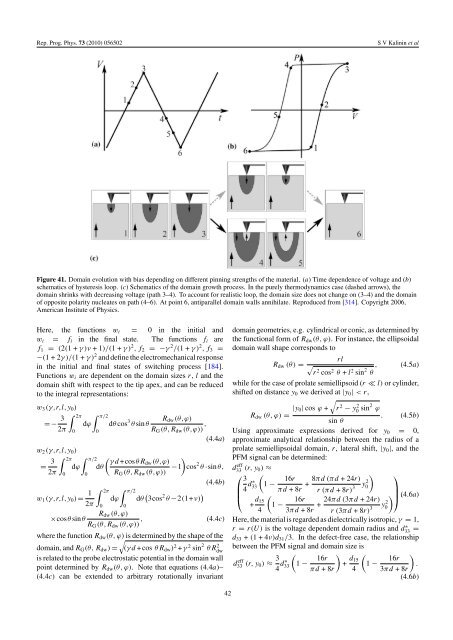Local polarization dynamics in ferroelectric materials
Local polarization dynamics in ferroelectric materials
Local polarization dynamics in ferroelectric materials
Create successful ePaper yourself
Turn your PDF publications into a flip-book with our unique Google optimized e-Paper software.
Rep. Prog. Phys. 73 (2010) 056502<br />
S V Kal<strong>in</strong><strong>in</strong> et al<br />
Figure 41. Doma<strong>in</strong> evolution with bias depend<strong>in</strong>g on different p<strong>in</strong>n<strong>in</strong>g strengths of the material. (a) Time dependence of voltage and (b)<br />
schematics of hysteresis loop. (c) Schematics of the doma<strong>in</strong> growth process. In the purely thermo<strong>dynamics</strong> case (dashed arrows), the<br />
doma<strong>in</strong> shr<strong>in</strong>ks with decreas<strong>in</strong>g voltage (path 3–4). To account for realistic loop, the doma<strong>in</strong> size does not change on (3–4) and the doma<strong>in</strong><br />
of opposite polarity nucleates on path (4–6). At po<strong>in</strong>t 6, antiparallel doma<strong>in</strong> walls annihilate. Reproduced from [314]. Copyright 2006,<br />
American Institute of Physics.<br />
Here, the functions w i = 0 <strong>in</strong> the <strong>in</strong>itial and<br />
w i = f i <strong>in</strong> the f<strong>in</strong>al state. The functions f i are<br />
f 1 = (2(1+γ)ν+1)/(1+γ) 2 ,f 2 = −γ 2 /(1+γ) 2 ,f 3 =<br />
−(1+2γ )/(1+γ) 2 and def<strong>in</strong>e the electromechanical response<br />
<strong>in</strong> the <strong>in</strong>itial and f<strong>in</strong>al states of switch<strong>in</strong>g process [184].<br />
Functions w i are dependent on the doma<strong>in</strong> sizes r, l and the<br />
doma<strong>in</strong> shift with respect to the tip apex, and can be reduced<br />
to the <strong>in</strong>tegral representations:<br />
w 3 (γ,r,l,y 0 )<br />
=− 3 ∫ 2π ∫ π/2<br />
dϕ dθ cos 3 R dw (θ,ϕ)<br />
θ s<strong>in</strong> θ<br />
2π 0 0<br />
R G (θ,R dw (θ,ϕ)) , (4.4a)<br />
w 2 (γ,r,l,y 0 )<br />
= 3 ∫ 2π<br />
dϕ<br />
2π<br />
0<br />
∫ π/2<br />
w 1 (γ,r,l,y 0 )= 1<br />
2π<br />
0<br />
( )<br />
γd+cosθRdw (θ,ϕ)<br />
dθ<br />
R G (θ,R dw (θ,ϕ)) −1 cos 2 θ ·s<strong>in</strong> θ,<br />
(4.4b)<br />
∫ 2π ∫ π/2<br />
dϕ dθ ( 3cos 2 θ −2(1+ν) )<br />
0<br />
0<br />
R dw (θ,ϕ)<br />
×cosθ s<strong>in</strong> θ<br />
R G (θ,R dw (θ,ϕ)) ,<br />
(4.4c)<br />
where the function R dw (θ, ϕ)<br />
√<br />
is determ<strong>in</strong>ed by the shape of the<br />
doma<strong>in</strong>, and R G (θ, R dw ) = (γ d +cos θR dw ) 2 +γ 2 s<strong>in</strong> 2 θRdw<br />
2<br />
is related to the probe electrostatic potential <strong>in</strong> the doma<strong>in</strong> wall<br />
po<strong>in</strong>t determ<strong>in</strong>ed by R dw (θ, ϕ). Note that equations (4.4a)–<br />
(4.4c) can be extended to arbitrary rotationally <strong>in</strong>variant<br />
doma<strong>in</strong> geometries, e.g. cyl<strong>in</strong>drical or conic, as determ<strong>in</strong>ed by<br />
the functional form of R dw (θ, ϕ). For <strong>in</strong>stance, the ellipsoidal<br />
doma<strong>in</strong> wall shape corresponds to<br />
rl<br />
R dw (θ) = √<br />
, (4.5a)<br />
r 2 cos 2 θ + l 2 s<strong>in</strong> 2 θ<br />
while for the case of prolate semiellipsoid (r ≪ l) or cyl<strong>in</strong>der,<br />
shifted on distance y 0 we derived at |y 0 |
















